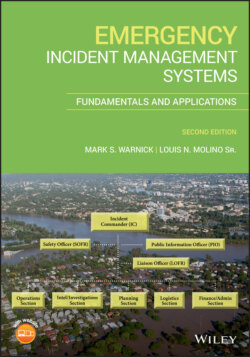Читать книгу Emergency Incident Management Systems - Mark Warnick S., Louis N. Molino Sr - Страница 84
3.20 New Zealand
ОглавлениеThe IMS system used by New Zealand is the Coordinated Incident Management System (CIMS) method. The CIMS method is very similar to the NIMS method used in the United States. This method was first introduced in 1998, and it is based on the same four basic tenets as the NIMS method, but they use different words. In New Zealand, those base tenets are identified as “Four‐Rs.” Those “Four Rs” are the following:
Risk reduction
Readiness
Response
Recovery (CIMS, 2014)
If we compare this to the NIMS method used in the United States, risk reduction is equivalent to mitigation, readiness is the equivalent of planning, and response and recovery are the same. Much like NIMS method, the Coordinated Incident Management System (CIMS, 2014) is flexible, uses common structures, roles, and responsibilities, it requires common terminology, and it is modular and scalable. This system is responsive to each community's needs, it fosters a coordination of response (among differing agencies), a coordination of resources, and integrates information management and communications. It also dictates a manageable span of control (number of people supervised), and it provides for the facilities needed for the response. It also is constantly evaluating the system to ensure that the Coordinated Incident Management System (CIMS) meets the ever‐changing needs of first responders. One minor difference that was found from the NIMS method is that the Coordinated Incident Management System (CIMS) appears to put more of an emphasis on international compatibility with other IMS methods (CIMS, 2014).
While the Coordinated Incident Management System (CIMS, 2014) method is similar to the NIMS method in many ways, there are also some subtle differences. One definition in the Coordinated Incident Management System (CIMS) method defines coordination as being assisted by a defined command and control. According to this definition, command is vertical to a single agency, while control is horizontal to outside agencies. Another difference is in the general staff positions. Instead of four (or five if Intelligence and Investigation is enacted) general staff functions, the New Zealand IMS method has six general staff functions, and they identify the Incident Commander (IC) as Control instead of command. These six functions are the following:
Intelligence
Planning
Operations
Logistics
Public Information Management
Welfare (CIMS, 2014)
The Coordinated Incident Management System (CIMS, 2014) is also different in providing an Incident Management Team (IMT) who assists the Controller. While an Incident Management Team (IMT) is often used in the United States, they are typically used to fill key position in ICS. New Zealand Incident Management Teams (IMT) are typically technical experts who provide advice based on special knowledge and handling of comprehensive work. The Incident Management Team (IMT), when activated, could contain a Response Manager, a Technical Expert, or other individuals who have specific information for that specific type of incident. The Incident Management Team (IMT) can also include risk advisors. All of the Incident Management Team (IMT) in the Coordinated Incident Management System (CIMS) report directly to control (CIMS, 2014).
Another interesting concept in the Coordinated Incident Management System (CIMS, 2014) method is the integration of the community into any response. While most IMS methods suggest connecting with the community, Coordinated Incident Management System (CIMS) method goes one step further. In the Coordinated Incident Management System (CIMS) manual, it states
Communities, organisations and businesses self‐respond to emergencies, either as part of official pre‐existing arrangements or on their own in a spontaneous or emergent manner. Response agencies need to accommodate, link with, support and coordinate community participation in response.
Wherever possible, communities and the business sector should be appropriately incorporated in response coordination planning before incidents occur. Although CIMS is designed to apply to official response agencies, its principles can be applied at the community level where they form part of such pre‐planned structures.
CIMS 2014, p. 13
The Coordinated Incident Management System (CIMS, 2014) method also provides a color scheme for each general staff function being performed. This method has assigned pink for planning, dark blue for investigations, and purple for public information. This color coding would seem to be more helpful when trying to identify the functional‐based individual you may need to interact with, or ask a question of, in an incident. The Coordinated Incident Management System (CIMS) method also provides a structure to identify the lines of authority between varying governmental agencies (CIMS, 2014), and while slightly different, it uses a planning process more like the German version of DV 100.
In looking at Coordinated Incident Management System (CIMS) using a holistic review, it more resembles the NIMS method of IMS, but it appears to be less complicated. While it may resemble NIMS, several stark differences have been revealed. Even with those differences, integration from Coordinated Incident Management System (CIMS) method to the NIMS method, or vice versa, would not be hard when an international incident occurs.
